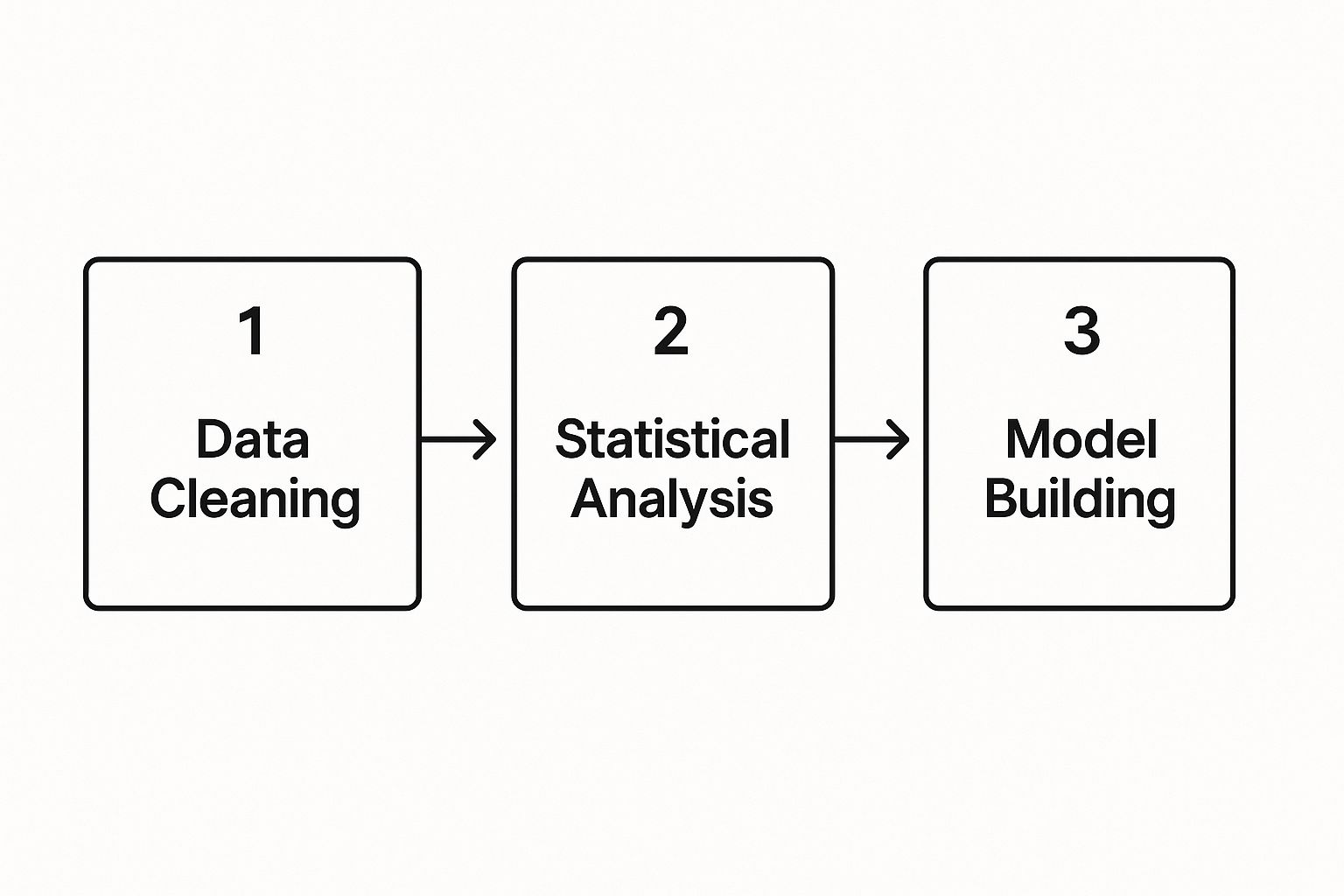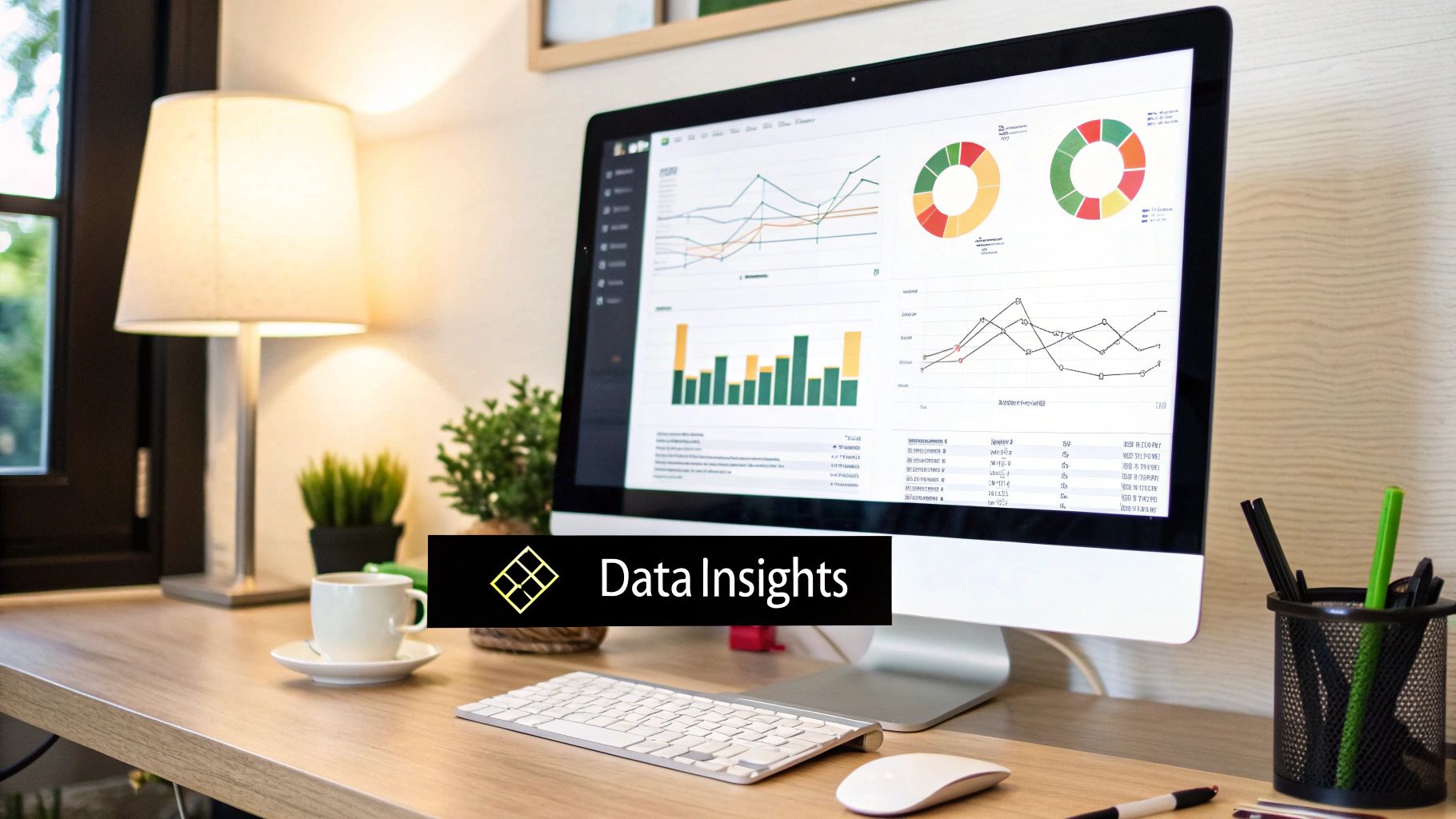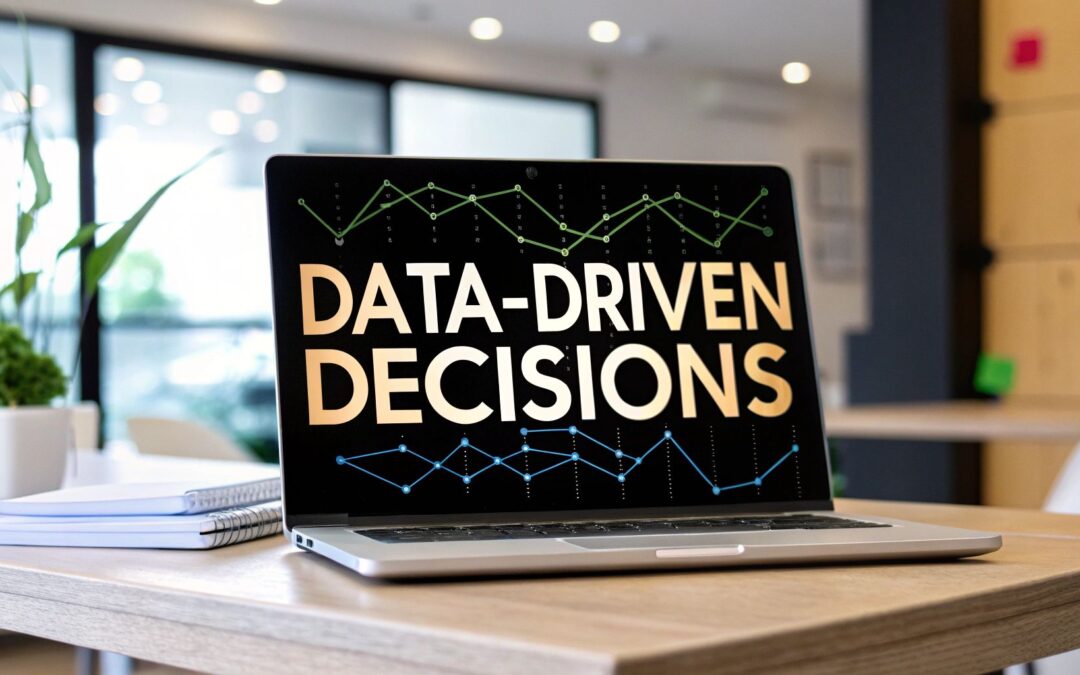At its most basic level, data-driven decision making (DDDM) is about making choices based on hard evidence, not just a gut feeling. It’s like a seasoned ship captain who trusts their years of experience but also relies on GPS, weather radar, and sonar to plot the best course. This approach doesn't dismiss intuition; it backs it up with verifiable facts, bringing a new level of confidence to business strategy.
What is Data-Driven Decision Making?
Getting into a data-driven mindset means shifting your company's culture from "we think this will work" to "we know this will work." It's less about replacing human judgment and more about enhancing it with objective insights. This empowers your teams to challenge old assumptions, uncover trends they never would have spotted, and validate a new direction before pouring money and time into it.
Instead of making big, risky bets based on a hunch, leaders can use data to build a solid business case. This turns what was once a mountain of confusing information into a powerful strategic advantage, leading to more predictable results and a culture where everyone is always learning and improving. It creates a powerful feedback loop: every decision and its outcome fuels the next, making the entire organization smarter over time.
From Gut Feelings to Tangible Evidence
Let's break down the fundamental difference. Traditional decision-making, while often fast and useful, can be easily swayed by personal bias, outdated experiences, or just plain incomplete information. A data-driven approach is designed to cut through that noise by anchoring every choice in something measurable.
This is especially critical now. The world is swimming in data—the global datasphere is expected to hit a staggering 175 zettabytes by 2025. That's a 430% increase from 2020. This data explosion is a huge opportunity for those who can make sense of it, and a huge challenge for those who can't. If you're curious, you can find more surprising analytics statistics that highlight just how big this trend is.
The real magic of data-driven decision making isn't just about having the data. It's about asking the right questions, having the curiosity to dig in, and—most importantly—having the discipline to listen to the answers, even when they contradict what you want to believe.
To see this in action, let's compare the two approaches side-by-side. The table below illustrates how differently organizations operate when they prioritize evidence over instinct.
Comparing Decision-Making Approaches
| Aspect | Traditional Decision Making | Data-Driven Decision Making |
|---|---|---|
| Foundation | Intuition, experience, "gut feelings" | Verifiable data, metrics, analysis |
| Mindset | "We believe this is the right way." | "The data shows this is the right way." |
| Risk Factor | High; susceptible to bias and assumptions | Lower; decisions are validated by evidence |
| Process | Often informal, based on authority | Systematic, repeatable, and transparent |
| Outcome | Unpredictable, hard to replicate success | More predictable, fosters continuous learning |
Ultimately, a data-driven culture is more resilient and adaptable because it's built on a foundation of reality, not just opinion.
The Three Pillars of a Data-First Culture
Simply buying a new piece of software won't make your organization data-driven. It's a fundamental shift that rests on three essential pillars working together:
- People: You need to build data literacy across the entire company. This isn't just for analysts; it's about making sure everyone from marketing to operations can comfortably read a chart, ask smart questions, and use data in their daily work.
- Processes: You must have clear, consistent methods for how you collect, clean, analyze, and act on data. Without standardized processes, you get unreliable results and teams arguing over whose numbers are "right."
- Technology: The right tools are crucial. You need platforms that make data easy to access and understand, turning raw numbers into clear dashboards and predictive models that people can actually use to make better decisions.
When these three elements—People, Processes, and Technology—are in sync, a business can stop just reacting to the past and start proactively shaping its future. It replaces ambiguity with a shared understanding of the facts, getting everyone on the same page and moving in the same direction.
Key Benefits of Building a Data-First Culture

When you weave data into the fabric of your daily operations, the benefits go way beyond just sounding modern. It gives you a real, tangible edge. Committing to a data-driven decision-making culture means your organization finally stops guessing and starts knowing. This shift leads to clearer, more confident actions that ripple through every single department.
Think about a retail store that used to order inventory based on last year’s sales and the manager's gut feeling. Now, by looking at real-time sales figures, foot traffic patterns, and even local event schedules, they can predict demand with astonishing accuracy. They stock what customers actually want, right when they want it, cutting waste and boosting profits.
This same data-first thinking works wonders in the digital space, too. A SaaS company can see exactly how people use its software, pinpointing the friction points where they get stuck or give up. Instead of just wondering why customer churn is high, they can see that users who skip a particular onboarding step are 50% more likely to cancel their subscription. With that knowledge, they can fix the workflow, improve the user experience, and build real loyalty.
Achieving Superior Strategic Foresight
One of the biggest wins from a data-first culture is the ability to shift from being reactive to proactive. When you consistently analyze market trends, competitor moves, and customer sentiment, you develop a powerful kind of strategic foresight. It’s like having a reliable weather forecast for your industry—you can spot storms and sunny spells long before they happen.
This lets you innovate with confidence, not fear. Instead of scrambling to respond to a competitor's new product, you can anticipate where the market is headed and get there first with solutions that meet emerging needs. The companies that get this right aren't just playing the game; they're changing how it's played.
By making data the foundation of your strategy, you build a resilient organization that can adapt and thrive amidst uncertainty. Decisions become less about individual opinions and more about a shared understanding of objective reality.
Unlocking Tangible Business Value
At the end of the day, the value of data-driven decisions shows up on the bottom line. Making this shift impacts your business in several concrete ways:
- Increased Efficiency: Teams spend less time arguing over opinions and more time acting on facts. Automating data analysis also frees up your people to focus on big-picture initiatives instead of getting bogged down in manual reports.
- Enhanced Customer Understanding: By digging into behavioral data, you can create incredibly detailed pictures of your customers. This allows you to personalize marketing, refine product features, and craft experiences that build genuine, lasting relationships.
- Improved Risk Management: Data models can flag potential risks—from supply chain hiccups to financial fraud—letting you create backup plans before a small problem becomes a crisis.
- Greater Profitability: Every single decision backed by data, whether it's optimizing ad spend or setting the right price, adds up to a healthier financial outlook. Businesses that really lean into data analytics often see profit improvements well above their industry average.
This strategic pivot isn't just about buying new software; it's about nurturing a whole new way of thinking. When every employee is empowered to ask questions and find answers in the data, the entire organization gets smarter and faster. This collective intelligence is the real engine of sustainable growth, creating a cycle of continuous improvement that competitors will find nearly impossible to copy.
Overcoming Common Implementation Challenges

Making the switch to a data-first culture is a smart move, but let’s be honest: it’s not always a smooth ride. The path is often filled with some very predictable hurdles. Think of it less like flipping a switch and more like a carefully planned expedition. Knowing what challenges to expect helps you prepare for them, turning potential roadblocks into genuine opportunities for growth.
The first and most common stumbling block? Data quality. The old saying, "garbage in, garbage out," has never been more relevant. If the data you're feeding your systems is messy, inconsistent, or just plain wrong, the insights you get out of it will be unreliable. This is the fastest way to erode trust in the entire process before it even gets off the ground.
To get ahead of this, you need to be militant about data hygiene right from the start. That means setting up clear, standardized processes for how data is collected, cleaned, and managed. For AI systems, this is even more critical. If you want to dive deeper, understanding why data annotation is critical for AI startups is a great place to start, as it ensures your models learn from the best possible information.
Bridging the Skills and Culture Gap
Once your data is in order, you’ll face the human side of the equation. A major challenge here is the internal skills gap. Many companies realize too late that their teams don't have the data literacy needed to really make sense of the information. It’s one thing to have a dashboard; it’s another to know how to interpret the charts, ask the right questions, and turn those numbers into action. This doesn’t mean you need an army of data scientists, though.
Instead, the focus should be on upskilling your current team. Invest in user-friendly tools that don't require a Ph.D. to operate and provide practical training that connects directly to their daily work. When employees see how data can help them solve their problems, you start to see real buy-in.
The goal is to build a culture of curiosity, where data is seen not as a threat or a chore, but as a powerful tool for problem-solving. Fostering this environment is key to turning skepticism into genuine engagement.
Another big hurdle is simply resistance to change. People who have relied on their gut and years of experience for decision-making can be wary of this new approach. They might feel it invalidates their hard-earned expertise or just adds another complicated step to their already busy day.
From Resistance to Adoption
You can’t just force a data-driven culture on people. Overcoming this resistance requires a more strategic, human-centric approach. Instead of a massive, top-down mandate, start small with a few pilot projects. Pick a specific, visible problem and use data to knock it out of the park. A clear, measurable win is your best marketing tool.
Here are a few practical steps to make the transition smoother:
- Secure Leadership Buy-In: Real change starts at the top. When leaders actively use data to make their own decisions and talk about it, it sends a clear signal that this is the new standard.
- Demonstrate Quick Wins: Nothing builds momentum like success. A great pilot project proves the concept's value and creates internal champions who will spread the word for you.
- Communicate Transparently: Be open about the goals and the process. Address concerns directly and make it clear that data is here to augment human expertise, not replace it.
By tackling data quality head-on, investing in your people's skills, and thoughtfully managing the cultural shift, you can lay a strong foundation for a successful data-driven organization.
Practical Frameworks for Data-Driven Decisions
Making great decisions with data isn't about luck; it's about having a solid game plan. If you just dip into your data here and there, you’ll get inconsistent, unreliable results. It’s like trying to build a house without blueprints. A proven framework, on the other hand, gives you a repeatable, step-by-step roadmap that guides your team from messy, raw data to clear, impactful business choices. These structures bring order to the chaos and make sure no critical step gets missed.
One of the most trusted and effective frameworks out there is known as OSEMN. Think of it as a five-stage assembly line for turning raw information into valuable insights. Each stage has a clear purpose, methodically transforming your data into a smart, defensible decision. This approach makes your data work not just more efficient, but far more powerful.
Understanding the OSEMN Framework
Let's unpack the OSEMN model. The acronym stands for Obtain, Scrub, Explore, Model, and Interpret. Each step flows logically into the next, creating a clear workflow that any team can put into practice.
-
Obtain: This is where it all begins—gathering the raw data. It could be pulled from your company's CRM, website analytics, social media feeds, or internal databases. The goal is to collect all the relevant pieces of the puzzle you need to solve your specific business problem.
-
Scrub: Let’s be honest, raw data is almost always a mess. This stage is all about cleaning and organizing it. That means getting rid of duplicates, fixing errors, and figuring out what to do with missing values. It's not glamorous, but it's absolutely essential. In fact, many data professionals report spending up to 80% of their time just on this cleaning process, which shows you how critical it is for getting accurate results.
-
Explore: Once your data is clean, you can start digging in. This is the initial investigation, where you look for patterns, interesting trends, and outliers. You'll often use charts and graphs to visualize the data, helping you form early ideas about what it’s telling you. It’s about getting a feel for the landscape before you bring in the heavy machinery.
-
Model: In this stage, you get more technical. You apply statistical methods or even machine learning algorithms to go deeper. The objective is to build a model that can either predict future outcomes or classify information, giving you a much more definitive answer to your core question.
-
Interpret: Finally, you have to translate the model's complex findings into a clear story that makes sense to everyone. This means communicating the results and recommending specific actions to stakeholders. It’s the art of turning numbers and charts into a persuasive plan.
Applying a Framework to a Real-World Problem
Let's make this real. Imagine a marketing team trying to improve the return on investment (ROI) for their campaigns.
They start by obtaining data from everywhere: ad spend from their various platforms, conversion data from Google Analytics, and customer lifetime value from their CRM. As expected, the initial dataset is a jumble. So, they move to the scrub phase, merging the different files and removing incomplete entries to create one clean, reliable source of truth.
The simplified visual below shows the technical core of what comes next.

This workflow highlights the heart of the process, where that clean data is analyzed and used to build predictive models that unlock much deeper insights.
With their clean data in hand, the team begins to explore. They create charts comparing which campaigns drove the most website traffic versus which ones actually led to sales. A surprising trend emerges: their most expensive campaign generates tons of clicks, but very few high-value customers.
A structured framework prevents you from jumping to conclusions. It forces you to validate your assumptions at each step, ensuring your final decision is built on a solid foundation of evidence, not just a surface-level observation.
Armed with this insight, they model the data to predict which customer segments are most likely to respond to different ad formats. The model confirms their suspicion: video ads on social media are far more effective at attracting high-value customers than the pricey search ads they were pouring money into.
Finally, they interpret these results and present a clear recommendation to leadership: shift 25% of the budget from search ads to social video campaigns. By sticking to the framework, they turned a vague goal into a specific, data-backed action plan poised to maximize ROI.
How AI Is Changing the Game in Data Analytics

AI is the engine driving the next wave of data-driven decision making. Think of it this way: if traditional data analytics gives you a detailed map of where you've been, AI-powered analytics is like a GPS that shows you the best route forward. It makes digging for insights faster, deeper, and more intuitive than ever before.
This technology automates the heavy lifting of data processing, uncovers predictive insights, and supports split-second decisions with incredible speed. It's not just a trend; the fusion of AI and analytics is fundamentally reshaping how businesses compete and operate on a global scale.
From Hindsight to Foresight
Traditional business intelligence (BI) is fantastic at telling you what happened. It provides the "hindsight" to answer questions like, “What were our sales last quarter?” But AI takes a giant leap forward into foresight, mainly through two powerful capabilities: predictive and prescriptive analytics.
-
Predictive analytics is like a weather forecast for your business. It sifts through historical and real-time data to tell you what’s likely to happen next. For example, it can flag which customers are most likely to churn or which products are about to trend next month.
-
Prescriptive analytics goes a step further. It doesn’t just show you the future; it recommends specific actions to get a better outcome. It might suggest the perfect discount to offer a customer to prevent them from leaving or tell you the ideal inventory level to maintain for a hot-selling product.
With AI, the conversation shifts from "What happened?" to "What's our best next move?" This proactive stance allows businesses to jump on opportunities and sidestep risks before they even fully emerge, creating a massive competitive edge.
Making Data Analytics Accessible to Everyone
Perhaps the biggest impact of AI is that it’s making data analysis a tool for everyone, not just the specialists. In the past, getting answers to complex questions meant waiting on a team of data scientists to write code and build models. This created a bottleneck that slowed the whole business down.
AI completely flips that script. Modern AI platforms are built for business users, often using conversational interfaces. Now, a marketing manager can ask a complex question in plain English and get an intelligent answer on the spot. This is made possible by technologies like Natural Language Processing (NLP), which allows computers to understand human language. You can learn more about Natural Language Processing (NLP) in our detailed guide.
This newfound accessibility empowers people across the organization—from sales to supply chain—to interact directly with data. They can test their own hunches, explore trends, and find solutions without needing a technical background. This doesn't just accelerate decision-making; it builds a more curious and capable culture where real-time, data-driven decision making is a reality for the entire team.
Your Path to Data-Driven Transformation with Zilo AI
It's one thing to understand the theory behind data-driven decision making, but it’s another thing entirely to put it into practice. This is where the real value comes alive. While good frameworks give you a map and AI provides the engine, actually assembling it all can feel overwhelming. That's where a partner like Zilo AI comes in, helping you move from ambition to real-world results by navigating the common pitfalls.
Think of a growing e-commerce company struggling to keep up. Their data is a complete mess, scattered across a dozen different platforms. Getting a clear picture of customer behavior feels impossible. The marketing team is basically guessing, and inventory is a constant headache. They know they need to use their data, but they just don't have the internal expertise to get it cleaned, analyzed, and ready for action.
This is a story we hear all the time. After bringing in Zilo AI, the company truly started to change. Our platform became their central data hub, automatically pulling in and cleaning information from all their different sources. What was once a messy, unusable pile of data suddenly became a reliable foundation for genuine insight.
From Complexity to Clarity
One of the biggest hurdles for any business is how complex data tools often seem. So many platforms are built for data scientists, not for the people in marketing, sales, or operations who actually need the answers hidden in the data. We designed Zilo AI specifically to close that gap with an intuitive and accessible approach.
Our dashboards turn complicated datasets into simple, interactive visuals. Instead of trying to make sense of dense spreadsheets, your team can instantly spot performance trends, identify customer segments, and see campaign results in clear charts and graphs. This process demystifies the data and gives everyone the confidence to explore it themselves. You can learn more about how user-friendly platforms are changing the game by reading about the uses and applications of low-code and no-code AI platforms.
The goal isn't just to give you data; it's to give you answers. Zilo AI is built to turn your team's natural curiosity into actionable intelligence, all without requiring them to write a single line of code.
Delivering a Clear Return on Investment
Any new technology has to prove its worth with tangible results. With Zilo AI, the benefits are clear, measurable, and directly impact your bottom line. We focus on three core areas:
- Automated Data Hygiene: Our system handles the tedious but critical work of cleaning data—removing duplicates, fixing errors, and standardizing formats. This ensures your decisions are always based on accurate, trustworthy information.
- Predictive AI Models: You get access to powerful forecasting tools without needing a dedicated team of data scientists. Our AI can help predict customer churn, forecast product demand, and flag high-potential sales opportunities, giving you a serious strategic edge.
- Simplified Reporting: Your teams can generate insightful reports in minutes, not days. This frees up countless hours, allowing them to focus on strategy and execution instead of getting bogged down in manual data work.
This approach is essential in today's market. The global AI market was valued at around $391 billion in 2025 and is projected to grow nearly five times over the next five years, with a compound annual growth rate of 35.9%. Getting a handle on AI-powered analytics is no longer a "nice-to-have" for businesses that want to grow. By equipping you with the right tools, Zilo AI helps you capitalize on this massive shift and positions you for long-term success.
Frequently Asked Questions About DDDM
Even after getting a handle on the concepts and frameworks, taking the first step into data-driven decision making (DDDM) can feel a bit daunting. Let's tackle some of the most common questions that pop up, clearing away any confusion so you can move forward with confidence.
Do I Need to Be a Data Scientist to Use Data?
Not at all. This is probably the biggest misconception out there. While data scientists are invaluable for deep, complex analysis, the whole point of creating a data-forward culture is to make data accessible for everyone. It’s about fostering data literacy—the ability for team members to comfortably read, interpret, and discuss data—not about turning your entire staff into statisticians.
Modern tools, Zilo AI included, are built with business users in mind. They offer intuitive dashboards and automated insights that let you ask questions and get clear answers, no coding required.
How Can a Small Business Start with Data-Driven Decisions?
The trick is to start small and be incredibly focused. A common mistake is trying to boil the ocean by analyzing everything at once. Instead, pick one high-impact business question and solve it.
For example, a great starting point is asking, "Which marketing channel is actually bringing us our most valuable customers?" You can begin answering this with data you already have sitting in common tools:
- Google Analytics can show you where your website visitors come from and what they do.
- Your sales platform (like Shopify or your CRM) holds all your purchase history.
- The native analytics on your social media pages reveal engagement and reach.
Scoring a quick, decisive win on a focused problem is the single best way to demonstrate the power of this approach. That initial success creates the momentum you need to justify investing more time and resources into your data efforts.
Think of it this way: Business Intelligence (BI) gives you the scoreboard. It uses dashboards and reports to show you what happened in the past and what's happening now. Data Analytics is the game analysis. It goes deeper to tell you why it happened, what's likely to happen next, and what you should do about it. BI describes; analytics prescribes.
How Do I Ensure My Data Is Accurate?
You can’t build a solid house on a shaky foundation, and you can’t make good decisions with bad data. Data quality is everything.
The first step is establishing clear, consistent standards for how your company collects and manages its information. This practice is called data governance, and it’s critical for preventing "garbage in, garbage out."
Next comes data cleaning. This is the hands-on work of finding and fixing errors, removing duplicate entries, and filling in missing values. It's an essential, though often time-consuming, part of the process. The good news is that many modern platforms can automate much of this cleanup, ensuring your insights are always based on data you can trust.
Ready to transform your operations and build a truly data-driven culture? Zilo AI provides the AI-ready data, skilled manpower, and intelligent tools you need to turn your information into your greatest asset. Start your data-driven journey with Zilo AI today.

